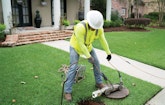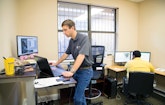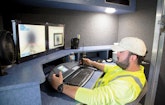“We are one of the few companies I know of that stay in our lane,” says David Guillory, CES vice president of business development. “We are strictly an evaluation and data company. We might look like a construction company, with excavators on pontoons, but we’re not a construction or engineering firm. We don’t make repairs. All we are doing is evaluating and providing data.”
This focus on providing comprehensive feedback to clients is accomplished by fielding technicians for such diverse tasks as high-pressure cleaning of lines; CCTV inspection; sonar, dye, and smoke testing; and locating cross bores, just to name a few services. The results of these field operations are recorded, tabulated in the CES data management center as needed, and otherwise jelled into useful information for clients.
“Specialization” is another term that helps define CES. Numerous clean-and-evaluate companies operate in areas where CES is active, but few are as well-equipped. “I would like to say there is competition in certain areas but not many others can take on the kinds of jobs we take on,” Guillory says. “We are very specialized.”
An example is an unusual pipe cleaning job in New Orleans. The pipe runs through a levee and is accessed from beneath a bridge. To reach it, equipment has to be floated. This is no problem because CES has a cleaning rig mounted on a pontoon boat as well as a tracked cleaning rig that can both float and crawl. Both pieces of equipment were custom fabricated. The company also uses two Marsh Master amphibious vehicles and three larger soft-track vehicles to reach places inaccessible to jet/vac trucks.
Its more conventional rolling stock includes 23 trucks — representing a mix of manufacturers — dedicated to cleaning operations and CCTV inspections. It even has an airborne fleet, sort of — three drones, the first one purchased in 2015. “A lot of the drone footage is for internal use, for helping us plan a job,” Guillory says. “In places that are hard to reach, we can send a drone over it and come back to the office and determine from its footage what pieces of equipment will be needed on a project.”
Specialized equipment separates CES from most competitors. The rest of the company’s edge comes from its expertise and, well, its steely resolve. “When municipalities are looking for ideas on how to evaluate a system, they come to us and ask, ‘How do we do this job?’ Even more important, once we get out into the field, we can run into so many kinds of problems, and that’s where we really separate ourselves from the competition,” Guillory says. “We never leave a job. Even if it turns out to be harder and more expensive than we planned, we never leave a job. Our reputation is on the line.”
Effective leadership
The company’s impressive reputation is mirrored in the brass at the top. Company President Brad Dutruch is an industry veteran of 25 years — since his high school days. “Brad sort of handpicked a team from across the country, people with a lot of experience, and oversaw the collection of equipment we need to do this kind of work,” Guillory says.
Along the way, Dutruch served a term as president of the National Association of Sewer Service Companies and is a certified trainer for pipeline assessment. One number summarizes his experience: 40 million. That’s how many linear feet of sanitary sewer pipe he’s helped evaluate. Over all, the company estimates it has cleaned 70 million feet of pipe since its incorporation in 1995.
The firm’s vice president, Joshua Hardy, has pretty impressive numbers as well. During his 20 years at the company, Hardy has managed sewer evaluations totaling 10 million linear feet, overseen 100 flow studies, and recommended rehab procedures for 2 million linear feet of pipe. He also is a professional engineer, as is Guillory, whose expertise is management. Guillory is a former director of the Department of Public Works for the city of Baton Rouge, where he managed 800 employees and negotiated and oversaw a $1.4 billion consent decree project to rehabilitate and enlarge the city’s system.
Not all CES expertise is at the top. The company’s 100 employees include veterans of the industry like project manager Tim Jacobs. After 32 years in the industry, Jacobs has supervised diving jobs and river basin cleaning projects, handled floating rigs and countless other pieces of equipment, and managed numerous routine cleaning projects. Jacobs has just about done it all, according to Guillory.
Jacobs is currently responsible for a sewer assessment and rehabilitation program in Memphis, Tennessee. CES technicians there are in the fifth year of an 8- to 10-year project, partnering with the city and with the global engineering firm Black & Veatch. More than 1 million feet have been evaluated, but there is plenty of work remaining. The system contains almost 3 million feet of pipe that’s 18 inches in diameter or smaller and another 385,000 feet of interceptor pipe ranging from 2 to 8 feet in diameter.
Building partnerships
In its work with cities, Compliance EnviroSystems often works directly for an engineering firm that has contracted with the city, which is the case in Memphis. Whereas in one of the company’s landmark jobs — a 10-year project in Atlanta created by a consent decree — the company worked more or less directly with city officials.
A third partnership model is evident in DeKalb County, Georgia, where CES interacts about equally with public officials and the consulting engineering company overseeing the project. “I think it depends on the resources a city has,” Guillory says. “Small cities a lot of times will lean on engineering firms to help them navigate the paperwork of a project.”
Guillory says it’s difficult to quantify how much each line of service contributes to the overall bottom line. He notes that evaluation and cleaning projects are often paired, with one preceding the other, though not always. The company’s ability to scour large-diameter pipes brings many cleaning-only jobs. In terms of evaluation services, standard CCTV inspections are most often requested, but CES technicians are also kept busy with high-definition TV examinations, dyeing of lateral joints, and cheap and quick smoke testing.
Cross-bore inspections make up another growing sector of work for the company. The cross bores typically result from a natural gas company boring a path for a new gas line and completing the project without realizing that the head of its boring unit passed through a drainline or sanitary sewer line. Laterally launched gas pipes follow the bore hole through the drainpipes.
“That creates a dangerous situation,” Guillory says. “If there is gas leakage, it can migrate into a sewer line and eventually from there into homes. The potential for an explosion is real, and that’s when the gas company becomes liable.”
This scenario has brought CES a different client base — private utility companies that own and manage the underground assets and are looking for these legacy cross-bore problems. CES already is working with utility clients in Texas, Mississippi and Georgia. “Companies are saying, let’s find and fix these cross bores and not put people at risk.”
Pushing boundaries
In 2005, hurricane recovery was the focus of the company’s work. Louisiana was struck by two major storms that year — Katrina in August and Rita a month later. Consequently, for the remainder of that year and some time thereafter, the company found all the work it could handle at its doorstep. Its crews helped with cleanup operations in numerous coastal locations as well as inland where communities struggled to restore their systems.
In addition, CES was contracted to manage restorative efforts in New Orleans. It oversaw a 100-truck, high-pressure fleet representing several contractors that cleaned, vacuumed, inspected and evaluated battered storm drains and sanitary sewer systems.
Yet in 2017, the company is not as Louisiana-centric as it was a dozen years ago. There are as many projects under way in Alabama and southeastern states as there are in Louisiana, not to mention three projects in Puerto Rico and a cleaning and evaluation job in the Pacific Ocean in Hawaii. CES looks more like a regional company now, with fingers reaching way offshore.
Guillory says circumstance, not a planned expansion, has the company working far from home.
“We go where the work is. We were created and are based in Baton Rouge, and over the years, we’ve mostly been in Louisiana. At the moment, it just happens that more than half of our projects are out-of-state, but that could change in the next 12 months.”
Cleaning up after Hurricane Katrina
When Hurricane Katrina struck New Orleans and areas north of the city in August 2005, it wreaked havoc on the infrastructure of the populated areas … and spawned opportunity for companies like Compliance EnviroSystems. The reality was that a 10-year-old sewer and drain cleaning company that was still establishing itself in the industry suddenly had a mess outside its door that begged to be cleaned up.
“Yes, I would say the Katrina effect was a turning point in our company history,” says David Guillory, CES vice president. The company subsequently was tapped to oversee some major cleanup in New Orleans and surrounding areas. It quickly geared up to supervise that work — as well as perform individual contracts — and never looked back.
The company cleaned 58,000 catch basins in New Orleans and 3 1/2 million linear feet of storm drainpipe. When Hurricane Rita made landfall the next month, CES technicians cleaned storm drains in adjacent St. Bernard and Jefferson parishes.
Guillory says heavily flooded areas in New Orleans produced a tragic windfall of clogged storm drains. The streets themselves were clogged as well, with cars tumbled over by wind and water and trailers that floated into lanes of traffic. “Getting to a storm drain access point was half the battle. It was just a workout. Our job started before we ever got to the inlets.”
At least a thousand people died during Katrina, according to federal officials. “But thankfully, we didn’t find any bodies during our work,” Guillory says. “We came in after the floodwaters had receded, though they were still doing search and recovery in the areas where we were working. Our crews did see search personnel recovering people and animals from nearby houses, but thankfully, we weren’t in the houses.”














